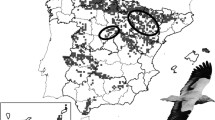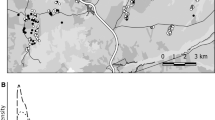Abstract
Large terrestrial long-lived birds (including raptors) are typically sedentary on islands, even when they are migratory on the mainland. Density-dependent variation in the age at first breeding has been described as responsible for the long-term persistence of long-lived bird populations on islands. However, sedentary island populations may also benefit from higher survival rates derived from the absence of migration costs, especially for young individuals. Thus, sedentary island populations can mimic a natural experiment to study migration costs. We estimated the age-dependent survival of two sedentary raptors on the island of Menorca (Egyptian vultures Neophron percnopterus and red kites Milvus milvus) and compared these estimates with those reported for other migratory and sedentary populations. In Menorca, Egyptian vultures, but not red kites, showed low levels of human-related mortality resulting in extremely high survival probabilities, probably due to different diet choices and behavioral patterns. Juvenile Egyptian vultures and red kites in the studied population had lower survival probabilities than adults. This difference, however, was smaller than those reported for mainland migrant populations, which showed a lower juvenile survival rate. In fact, between-population comparisons suggested that survival of the young in migrant populations may be triggered by mortality factors in wintering areas. In contrast, adult survival may respond to mortality factors in breeding areas. Our results suggest that raptor species that become sedentary on islands may benefit from higher pre-breeder survival prospects in comparison with their mainland migrant counterparts. This fact, in combination with an earlier age at first reproduction, may facilitate their persistence.



Similar content being viewed by others
References
Agudo R, Carrete M, Alcaide M, Rico C, Hiraldo F, Donázar JA (2012) Genetic diversity at neutral and adaptive loci determines individual fitness in a long-lived territorial bird. Proc R Soc B Biol Sci 279:3241–3249
Alerstam T, Hedenström A, Åkesson S (2003) Long-distance migration: evolution and determinants. Oikos 103:247–260
Bannerman DA, Bannerman WM, Reid-Henry DM (1968) Birds of the Atlantic islands. Oliver & Boyd, Edinburgh
Bellebaum J, Korner-Nievergelt F, Dürr T, Mammen U (2013) Wind turbine fatalities approach a level of concern in a raptor population. J Nat Conserv 21:394–400
Berthold P (2001) Bird migration: a general survey. Oxford University Press, Oxford
BirdLife International (2014) IUCN red list for birds. http://www.iucn.org/
Blondel J, Pradel R, Lebreton J-D (1992) Low fecundity insular blue tits do not survive better as adults than high fecundity mainland ones. J Anim Ecol 61:205–213
Boyer AG (2010) Consistent ecological selectivity through time in Pacific island avian extinctions. Conserv Biol 24:511–519
Brouwer L, Tinbergen JM, Both C, Bristol R, Richardson DS, Komdeur J (2009) Experimental evidence for density-dependent reproduction in a cooperatively breeding passerine. Ecology 90:729–741
Burnham KP, Anderson DR (2002) Model selection and multi-model inference: a practical information-theoretic approach. Springer, New York
Carrete M, Sánchez-Zapata JA, Benítez JR, Lobón M, Donázar JA (2009) Large scale risk-assessment of wind-farms on population viability of a globally endangered long-lived raptor. Biol Conserv 142:2954–2961
Carrete M, Bortolotti GR, Sánchez-Zapata JA, Delgado A, Cortés-Avizanda A, Grande JM, Donázar J (2013) Stressful conditions experienced by endangered Egyptian vultures on African wintering areas. Anim Conserv 16:353–358
Choquet R, Lebreton J, Gimenez O, Reboulet AM, Pradel R (2009a) U-CARE: utilities for performing goodness of fit tests and manipulating Capture–REcapture data. Ecography 32:1071–1074
Choquet R, Rouan L, Pradel R (2009b) Program E-SURGE: a software application for fitting multievent models. In: Cooch E, Conroy M, Thomson D (eds) Modeling demographic processes in marked populations. Springer, Berlin, pp 845–865
Congost J, Muntaner J (1974) Presencia otoñal e invernal y concentración de Neophron percnopterus en la isla de Menorca. Misc Zool 3:151–161
Cortés-Avizanda A, Ceballos O, Donázar J (2009) Long-term trends in population size and breeding success in the Egyptian vulture (Neophron percnopterus) in Northern Spain. J Raptor Res 43:43–49
Cramp S, Simmons K (1977) Birds of the western Palearctic: handbook of the birds of Europe, the Middle East and North Africa. Oxford University Press, Oxford
De Pablo F (2002) La situación del alimoche, Neophron percnopterus, en las Islas Baleares. Anu Ornitol Balear 17:53–57
De Pablo F (2004) Bases Ecológicas para la elaboración de un plan de recuperación de la población de milanos reales, Milvus milvus. PhD dissertation, Universidad de Barcelona, Barcelona
Donázar J (1993) The Iberian vultures. Biology and conservation. Reyero, Madrid
Donázar JA, Ceballos O, Tella JL (1996) Communal roosts of Egyptian vultures (Neophron percnopterus): dynamics and implications for the species conservation. In: Muntaner J, Mayol J (eds) Biologı́a y Conservación de las Rapaces Mediterráneas, 1994 (Monografı́as no 4), SEO, pp 189–202
Donázar JA, Palacios CJ, Gangoso L, Ceballos O, González MJ, Hiraldo F (2002) Conservation status and limiting factors in the endangered population of Egyptian vulture (Neophron percnopterus) in the Canary Islands. Biol Conserv 107:89–97
Donázar JA, Gangoso L, Forero MG, Juste J (2005) Presence, richness and extinction of birds of prey in the Mediterranean and Macaronesian islands. J Biogeogr 32:1701–1713
Ferrer M, Otalora F, García-Ruiz JM (2004) Density-dependent age of first reproduction as a buffer affecting persistence of small populations. Ecol Appl 14:616–624
Ferrer M, Bildstein K, Penteriani V, Casado E, de Lucas M (2011) Why birds with deferred sexual maturity are sedentary on islands: a systematic review. PLoS One 6:e22056
Forero MG, Donázar JA, Blas J, Hiraldo F (1999) Causes and consequences of territory change and breeding dispersal distance in the black kite. Ecology 80:1298–1310
Forslund P, Pärt T (1995) Age and reproduction in birds-hypotheses and tests. Trends Ecol Evol 10:374–378
Gangoso L, Agudo R, Anadón JD, de la Riva M, Suleyman AS, Porter R, Donázar JA (2013) Reinventing mutualism between humans and wild fauna: insights from vultures as ecosystem services providers. Conserv Lett 6:172–179
Grande JM, Serrano D, Tavecchia G, Ceballos O, Díaz-Delgado R, Tella JL, Donázar JA (2009) Survival in a long-lived territorial migrant: effects of life-history traits and ecological conditions in wintering and breeding areas. Oikos 118:580–590
Greig S, Coulson J, Monaghan P (1983) Age-related differences in foraging success in the herring gull (Larus argentatus). Anim Behav 31:1237–1243
Hernández M, Margalida A (2009) Poison-related mortality effects in the endangered Egyptian vulture (Neophron percnopterus) population in Spain. Eur J Wildl Res 55:415–423
Kéry M, Schaub M (2012) Bayesian population analysis using WinBUGS: a hierarchical perspective. Academic Press, Dublin
Klaassen RH, Hake M, Strandberg R, Koks BJ, Trierweiler C, Exo KM, Bairlein F, Alerstam T (2014) When and where does mortality occur in migratory birds? Direct evidence from long-term satellite tracking of raptors. J Anim Ecol 83:176–184
Knott J, Newbery P, Barov B (2009) Action plan for the red kite Milvus milvus in the European Union, p. 55. http://ec.europa.eu/environment/nature/conservation/wildbirds/action_plans/docs/milvus_milvus.pdf
Lande R (1988) Genetics and demography in biological conservation. Science 241:1455–1460
Lok T, Overdijk O, Piersma T (2013) Migration tendency delays distributional response to differential survival prospects along a flyway. Am Nat 181:520–531
López-López P, García-Ripollés C, Urios V (2013) Food predictability determines space use of endangered vultures: implications for management of supplementary feeding. Ecol Appl 24:938–949
López-López P, García-Ripollés C, Urios V (2014) Individual repeatability in timing and spatial flexibility of migration routes of trans-Saharan migratory raptors. Curr Zool 60:642–652
Mihoub J-B, Gimenez O, Pilard P, Sarrazin F (2010) Challenging conservation of migratory species: Sahelian rainfalls drive first-year survival of the vulnerable lesser kestrel Falco naumanni. Biol Conserv 143:839–847
Morris WF, Doak DF (2002) Quantitative conservation biology. Sinauer, Sunderland
Newton I (1989) Lifetime reproduction in birds. Academic Press, London
Newton I (2006) Can conditions experienced during migration limit the population levels of birds? J Ornithol 147:146–166
Newton I, Davis PE, Davis JE (1989) Age of first breeding, dispersal and survival of red kites Milvus milvus in Wales. Ibis 131:16–21
Oro D, Margalida A, Carrete M, Heredia R, Donazar JA (2008) Testing the goodness of supplementary feeding to enhance population viability in an endangered vulture. PLoS One 3:e4084
Oro D, Genovart M, Tavecchia G, Fowler MS, Martínez-Abraín A (2013) Ecological and evolutionary implications of food subsidies from humans. Ecol Lett 16:1501–1514
Owens IPF, Bennett PM (2000) Ecological basis of extinction risk in birds: habitat loss versus human persecution and introduced predators. Proc Natl Acad Sci USA 97:12144–12148
Pradel R (2005) Multievent: an extension of multistate capture–recapture models to uncertain states. Biometrics 61:442–447
Pradel R, Gimenez O, Lebreton J (2005) Principles and interest of GOF tests for multistate capture–recapture models. Anim Biodivers Conserv 28:189–204
Sæther B-E, Bakke Ø (2000) Avian life history variation and contribution of demographic traits to the population growth rate. Ecology 81:642–653
Sanz-Aguilar A, Bechet A, Germain C, Johnson AR, Pradel R (2012) To leave or not to leave: survival trade-offs between different migratory strategies in the greater flamingo. J Anim Ecol 81:1171–1182
Sanz-Aguilar A, Tavecchia G, Afán I, Ramírez F, Doxa A, Bertolero A, Gutiérrez-Expósito C, Forero MG, Oro D (2014) Living on the edge: demography of the slender-billed gull in the Western Mediterranean. PLoS One 9:e92674
Sanz-Aguilar A, Sánchez-Zapata JA, Carrete M, Benítez JR, Ávila E, Arenas R, Donázar JA (2015) Action on multiple fronts, illegal poisoning and wind farm planning, is required to reverse the decline of the Egyptian vulture in Southern Spain. Biol Conserv 187:10–18
Sarrazin F, Bagnolini C, Pinna JL, Danchin E, Clobert J (1994) High survival estimates of griffon vultures (Gyps fulvus fulvus) in a reintroduced population. Auk 111:853–862
Schaub M (2012) Spatial distribution of wind turbines is crucial for the survival of red kite populations. Biol Conserv 155:111–118
Schaub M, Pradel R, Lebreton J-D (2004) Is the reintroduced white stork (Ciconia ciconia) population in Switzerland self-sustainable? Biol Conserv 119:105–114
Schaub M, Kania W, Köppen U (2005) Variation of primary production during winter induces synchrony in survival rates in migratory white storks Ciconia ciconia. J Anim Ecol 74:656–666
Sergio F, Tavecchia G, Blas J, López L, Tanferna A, Hiraldo F (2011) Variation in age-structured vital rates of a long-lived raptor: implications for population growth. Basic Appl Ecol 12:107–115
Sergio F, Tanferna A, De Stephanis R, López-Jiménez L, Blas J, Tavecchia G, Preatoni D, Hiraldo F (2014) Individual improvements and selective mortality shape lifelong migratory performance. Nature 515:410–413
Smart J, Amar A, Sim IM, Etheridge B, Cameron D, Christie G, Wilson JD (2010) Illegal killing slows population recovery of a re-introduced raptor of high conservation concern–the red kite Milvus milvus. Biol Conserv 143:1278–1286
Tavecchia G, Adrover J, Navarro AM, Pradel R (2012) Modelling mortality causes in longitudinal data in the presence of tag loss: application to raptor poisoning and electrocution. J Appl Ecol 49:297–305
Tenan S, Adrover J, Navarro AM, Sergio F, Tavecchia G (2012) Demographic consequences of poison-related mortality in a threatened bird of prey. PLoS One 7:e49187
Walter HS (1990) Small viable population: the red-tailed hawk of Socorro Island. Conserv Biol 4:441–443
Warkentin IG, James PC, Oliphant LW (1990) Body morphometrics, age structure, and partial migration of urban merlins. Auk 107:25–34
White GC, Burnham KP (1999) Program MARK: survival estimation from populations of marked animals. Bird Study 46:S120–S139
Whittaker RJ, Fernández-Palacios JM (2007) Island biogeography: ecology, evolution, and conservation. Oxford University Press, Oxford
Zar JH (1999) Biostatistical analysis. Prentice Hall, New Jersey
Acknowledgments
We are grateful to Giacomo Tavecchia for his statistical advice and comments. This work was partially funded by projects JCI-2011-09085, CGL2012-40013-C02-01-02, a Severo Ochoa Excellence Award (SEV-2012-0262) from the Ministerio de Economía y Competitividad of the Spanish Government and EU FEDER funds. The Regional Government of the Balearic Islands provided permits to capture birds and financed part of the work.
Conflict of interest
The authors declare that they have no conflict of interest.
Ethical approval
All applicable institutional and/or national guidelines for the care and use of animals were followed.
Author information
Authors and Affiliations
Corresponding author
Additional information
Communicated by Scott McWilliams.
Electronic supplementary material
Below is the link to the electronic supplementary material.
Rights and permissions
About this article
Cite this article
Sanz-Aguilar, A., De Pablo, F. & Donázar, J.A. Age-dependent survival of island vs. mainland populations of two avian scavengers: delving into migration costs. Oecologia 179, 405–414 (2015). https://doi.org/10.1007/s00442-015-3355-x
Received:
Accepted:
Published:
Issue Date:
DOI: https://doi.org/10.1007/s00442-015-3355-x




